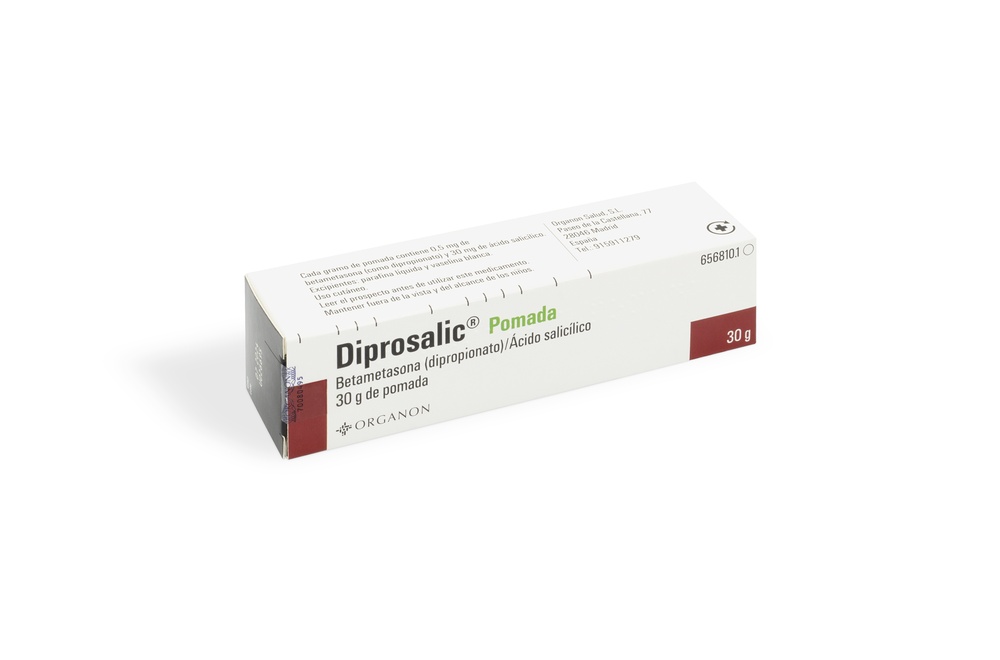

ДІПРОСАЛІК мазь

Запитайте лікаря про рецепт на ДІПРОСАЛІК мазь

Інструкція із застосування ДІПРОСАЛІК мазь
Введення
Опис: інформація для користувача
Діпросалік мазь
Бетаметазон дипропіонат / Саліцилова кислота
Прочитайте уважно весь опис перед тим, як почнете використовувати цей лікарський засіб, оскільки він містить важливу інформацію для вас.
- Збережіть цей опис, оскільки вам може знадобитися знову його прочитати.
- Якщо у вас виникли питання, проконсультуйтеся з вашим лікарем або фармацевтом.
- Цей лікарський засіб призначено тільки для вас, і його не слід давати іншим людям, навіть якщо вони мають такі самі симптоми, як у вас, оскільки це може їм нашкодити.
- Якщо ви відчуваєте побічні ефекти, проконсультуйтеся з вашим лікарем або фармацевтом, навіть якщо це побічні ефекти, які не вказані в цьому описі. Див. розділ 4.
Зміст опису
- Що таке Діпросалік мазь і для чого вона використовується
- Що вам потрібно знати перед тим, як почнете використовувати Діпросалік мазь
- Як використовувати Діпросалік мазь
- Можливі побічні ефекти
- Зберігання Діпросалік мазі
- Зміст упаковки та додаткова інформація
1. Що таке Діпросалік мазь і для чого вона використовується
Діпросалік мазь - це лікарський засіб, який містить у складі активних речовин бетаметазон (дипропіонат) і саліцилову кислоту. Бетаметазон (дипропіонат) - це кортикостероїд (протизапальний засіб), який при нанесенні на шкіру зменшує червоність, запалення та свербіж, викликані певними проблемами шкіри. Саліцилова кислота зменшує товщину лускових шарів на поверхні шкіри, викликаних захворюванням (кератолітичний ефект), що дозволяє бетаметазону проникнути в нижні шари ураженої шкіри.
Діпросалік мазь призначено для лікування запальних проявів певних захворювань шкіри, при яких зовнішній шар має лускові шари (гіперкератоз) та сухі чутливі до кортикостероїдів, наприклад, псоріаз та лікен планус.
2. Що вам потрібно знати перед тим, як почнете використовувати Діпросалік мазь
Не використовуйте Діпросалік мазь:
- якщо ви алергічні на бетаметазон (дипропіонат), саліцилову кислоту або будь-які інші компоненти цього лікарського засобу (перелічені в розділі 6).
- якщо ви страждаєте на туберкульоз, сифіліс або вірусні інфекції (наприклад, герпес або вітрянка).
- на ділянках шкіри, уражених розáceєю, акне або періоральної дерматитом.
- при захворюваннях шкіри з атрофією.
- на ділянках шкіри, які показують реакцію на вакцину, тобто червоність або запалення після вакцинації.
- в очі чи на ранах.
- якщо ви страждаєте на цукровий діабет.
- у дітей молодших 2 років.
- якщо ви страждаєте на грибкові інфекції на будь-якій частині тіла.
Попередження та застереження
Проконсультуйтеся з вашим лікарем або фармацевтом перед тим, як почнете використовувати Діпросалік мазь.
- Кортикостероїди, як один з активних речовин цього лікарського засобу, мають суттєві ефекти на організм. Не рекомендується використовувати Діпросалік мазь на великих ділянках тіла чи тривалий час, оскільки це значно збільшує ризик побічних ефектів.
- Не слід застосовувати лікарський засіб з окулярними пов'язками (або матеріалами, непроникними для повітря, такими як деякі підгузники).
- Не слід застосовувати лікарський засіб у складках шкіри, таких як пахва чи пахові ділянки.
- Не слід застосовувати на обличчі.
- Якщо виникає подразнення або гіперчутливість, слід припинити лікування та проконсультуватися з лікарем.
- Якщо ви розвиваєте інфекцію під час використання цього лікарського засобу, слід проконсультуватися з лікарем щодо лікування.
- Діпросалік мазь не повинна вступати в контакт з очима, відкритими ранами чи слизистими оболонками (наприклад, генітальною областю). У разі контакту з очима промийте їх водою протягом 15 хвилин.
- Побічні ефекти, описані при використанні кортикостероїдів, включаючи порушення функції наднирників, можуть виникнути також при місцевому застосуванні через абсорбцію активної речовини в організм, особливо при тривалому застосуванні на великих ділянках шкіри чи з окулярними пов'язками. Це відбувається особливо у дітей.
- Якщо ви використовуєте Діпросалік мазь для захворювань, інших ніж ті, для яких вона призначена, це може маскувати симптоми та ускладнити правильну діагностику та лікування
- Якщо у вас є проблеми з циркуляцією, слід повідомити лікаря.
- Зв'яжіться з лікарем, якщо у вас виникли розмиті зору чи інші порушення зору.
Діти
Цей лікарський засіб протипоказаний у дітей молодших 2 років і не рекомендується у дітей молодших 12 років.
У дітей більш ймовірно, що кортикостероїд буде всмоктуватися в організм через шкіру та мати побічні ефекти в інших ділянках тіла, ніж у дорослих пацієнтів.
У дітей, які лікувалися місцевими кортикостероїдами, повідомлялося про порушення функції наднирників, що призводить до появи симптомів, таких як ожиріння, затримка росту тощо (синдром Кушинга) або підвищення внутрішньочерепного тиску (гіпертензія), який може проявлятися, серед іншого, як випуклість.fontanel у немовлят та головний біль.
Використання Діпросалік мазі з іншими лікарськими засобами
Повідомте лікаря або фармацевта, якщо ви використовуєте, нещодавно використовували або можете використовувати інші лікарські засоби.
Не відомі взаємодії Діпросалік мазі з іншими лікарськими засобами.
Вагітність,лактаціята фертильність
Якщо ви вагітні або годуєте грудьми, вважаєте, що можете бути вагітною або плануєте вагітність, проконсультуйтеся з лікарем або фармацевтом перед тим, як використовувати цей лікарський засіб.
Вагітність
Загалом, під час першого триместру вагітності не слід застосовувати Діпросалік мазь.
Не слід використовувати Діпросалік мазь під час вагітності, якщо тільки лікар не вважає, що потенційний користь від її використання виправдовує потенційний ризик для плоду.
Вагітні жінки або ті, які планують вагітність, не повинні використовувати Діпросалік мазь на великих ділянках шкіри, у великих кількостях або тривалий час, а також не повинні використовувати окулярні пов'язки.
Лактація
Не наносіть Діпросалік мазь на груди під час годування грудьми; не дозволяйте дитині вступати в контакт з обробленими ділянками.
Не використовуйте цей лікарський засіб під час годування грудьми, якщо тільки лікар не призначить його, і не використовуйте його на великих ділянках шкіри, у великих кількостях або тривалий час, а також не використовуйте окулярні пов'язки.
Водіння транспортних засобів та використання машин
Не застосовується.
3. Як використовувати Діпросалік мазь
Слідуйте точно інструкціям щодо застосування цього лікарського засобу, вказаним вашим лікарем. У разі сумнівів проконсультуйтеся з лікарем або фармацевтом.
Рекомендована доза:
Дорослі та діти старші 12 років:
Нанесіть тонкий шар мазі на уражену ділянку 1-2 рази на день, вранці та/або ввечері.
У деяких випадках лікар може призначити меншу частоту нанесення, якщо це достатньо для вашого захворювання.
Тривалість лікування не повинна перевищувати 2 тижні.
Місцеве застосування.
Мазь слід наносити тонким шаром з легким масажем, покриваючи уражену ділянку.
Використання у дітей
Діпросалік мазь не призначена для дітей молодших 12 років та протипоказана у дітей молодших 2 років.
Якщо ви використовуєте більше Діпросалік мазі, ніж потрібно
Надмірне використання місцевих кортикостероїдів (повторна передозування) може призвести до побічних ефектів (див. розділ 4).
Якщо ви використовуєте мазь частіше, ніж потрібно, або на великих ділянках шкіри, вона може бути всмокнута в організм та призвести до різних розладів; у дітей це може вплинути на їхній рост та розвиток. Також можуть виникнути нудота, блювота та звук у вухах.
У випадках хронічної інтоксикації рекомендується поступове припинення кортикостероїдів. Лікування передозування є симптоматичним. Симптоми гострої передозування кортикостероїдів зазвичай є оборотними.
У разі передозування або випадкового прийому внутрішньо проконсультуйтеся з лікарем або фармацевтом або зверніться до медичного центру чи телефонуйте на номер служби токсикологічної інформації. Тел.: 91 562 04 20 (зазначаючи лікарський засіб та кількість, прийняту всередину).
Якщо ви забули використовувати Діпросалік мазь
Не наносіть подвійну дозу для компенсації пропущених доз.
Нанесіть дозу якнайшвидше та продовжуйте лікування згідно з вашим звичайним графіком.
Якщо ви припините лікування Діпросалік маззю
Якщо у вас є будь-які інші питання щодо використання цього лікарського засобу, проконсультуйтеся з лікарем або фармацевтом.
4. Можливі побічні ефекти
Як і всі лікарські засоби, цей лікарський засіб може призвести до побічних ефектів, хоча не всі люди їх відчувають.
Відповідно до даних про використання кортикостероїдів, особливо при тривалому застосуванні на великих ділянках шкіри, з окулярними пов'язками чи матеріалами, та/або у дітей, повідомлялися наступні реакції:
- Паління або відчуття жару
- Свербіж
- Атрофія шкіри
- Підразнення шкіри
- Зміни кольору шкіри
- Сухість або тріщини на шкірі
- Лущення шкіри
- Червоність (еритема)
- Синяки
- Поява червоних плям
- Запалення волосяних фолікулів (фолікуліт)
- Збільшення волосяного покриву
- Запалення шкіри навколо рота (періоральний дерматит).
- Стрії на шкірі
- Акне
- Макерація шкіри
- Алергічна реакція шкіри (контактний дерматит)
- Мілліарія (червоні та білі зерна на різних частинах тіла)
- Втрати волосся
- Абnormalна чутливість шкіри, така як оніміння, поколювання, колючі відчуття або жар на шкірі (парестезія)
- Інфекції
Побічні ефекти можуть виникнути не тільки на обробленій ділянці, але й на інших ділянках тіла, якщо активна речовина всмоктується в організм через шкіру.
Це, наприклад, може підвищити внутрішньоочний тиск (глаукома) або призвести до захворювання, характеризованого округлими щоками, накопиченням жиру, кифозом, затримкою загоєння ран, психічними симптомами тощо (синдром Кушинга); підвищення внутрішньочерепного тиску, катаракти та розмитість зору з невідомою частотою (не може бути оцінена на основі доступних даних).
Сповіщення про побічні ефекти
Якщо ви відчуваєте будь-які побічні ефекти, проконсультуйтеся з лікарем або фармацевтом, навіть якщо це можливі побічні ефекти, які не вказані в цьому описі. Також можете повідомити про них безпосередньо через Систему фармакологічного нагляду за лікарськими засобами для людини: https://www.notificaram.es. Надсилаючи повідомлення про побічні ефекти, ви можете допомогти надати більше інформації про безпеку цього лікарського засобу.
5. Зберігання Діпросалік мазі
Не потребує спеціальних умов зберігання.
Тримайте цей лікарський засіб поза зоною досяжності дітей.
Не використовуйте цей лікарський засіб після закінчення терміну придатності, вказаного на упаковці після зазначення "CAD". Термін придатності - останній день місяця, який вказано. Використовуйте протягом трьох місяців після відкриття.
Не використовуйте цей лікарський засіб, якщо ви спостерігаєте будь-які видимі ознаки псування. Проконсультуйтеся з лікарем, якщо ви спостерігаєте будь-які зміни у зовнішньому вигляді Діпросалік мазі.
Лікарські засоби не слід викидати у водопровідні труби чи сміття. Відкладайте упаковки та лікарські засоби, які вам не потрібні, у пункт збору фармацевтичного сміття. У разі сумнівів проконсультуйтеся з фармацевтом, як позбуватися упаковок та лікарських засобів, які вам не потрібні. Таким чином, ви допоможете захистити довкілля.
6. Зміст упаковки та додаткова інформація
Склад Діпросалік мазі
- Активні речовини - бетаметазон (дипропіонат) та саліцилова кислота.
Кожен грам мазі містить 0,5 мг бетаметазону (0,05%) (0,64 мг бетаметазону дипропіонату) та 30 мг саліцилової кислоти (3%).
- Інші компоненти (експіцієнти) - рідка парафінна мазь та біла вазелінова мазь.
Вигляд продукту та вміст упаковки
Діпросалік мазь - це мазь білого кольору та м'якої текстури.
Випускається у тубах по 30 г мазі.
Уповноважена особа та виробник
Уповноважена особа:
Organon Salud, S.L.
Paseo de la Castellana, 77
28046 Madrid
Іспанія
Тел.: 915911279
Виробник:
Organon Heist bv
Industriepark 30
2220 Heist-op-den-Berg
Бельгія
Дата останнього перегляду цього опису: вересень 2017 року.
Детальна та актуальна інформація про цей лікарський засіб доступна на сайті Іспанського агентства лікарських засобів та медичних продуктів (AEMPS) http://www.aemps.gob.es/

Скільки коштує ДІПРОСАЛІК мазь в Іспанії у 2025 році?
ДІПРОСАЛІК мазь коштує в середньому 3.12 євро у листопад, 2025 році. Ціна може змінюватися залежно від регіону, аптеки та наявності рецепта. Рекомендуємо перевіряти актуальну вартість у місцевих аптеках або через онлайн-сервіси.
- Країна реєстрації
- Середня ціна в аптеках3.12 EUR
- Діючі речовини
- Потрібен рецептТак
- Виробник
- Інформація є довідковою і не є медичною порадою. Перед прийомом будь-яких препаратів обов'язково проконсультуйтеся з лікарем. Oladoctor не несе відповідальності за медичні рішення, прийняті на основі цього контенту.
- Альтернативи до ДІПРОСАЛІК мазьФорма випуску: КРЕМ, -Діючі речовини: betamethasoneВиробник: Faes Farma S.A.Потрібен рецептФорма випуску: КРЕМ, 1 мг; 10 мг; 0,5 мг; 10 мгДіючі речовини: betamethasoneВиробник: Galenicum Derma S.L.U.Потрібен рецептФорма випуску: РОЗЧИН ДЛЯ ЗОВНІШНЬОГО ЗАСТОСУВАННЯ, 0.5 мг/г + 20 мг/гДіючі речовини: betamethasoneВиробник: Mibe Pharma Espana S.L.Потрібен рецепт
Аналоги ДІПРОСАЛІК мазь в інших країнах
Найкращі аналоги з тією самою діючою речовиною та терапевтичним ефектом.
Аналог ДІПРОСАЛІК мазь у Польша
Аналог ДІПРОСАЛІК мазь у Украина
Лікарі онлайн щодо ДІПРОСАЛІК мазь
Консультація щодо дозування, побічних ефектів, взаємодій, протипоказань та поновлення рецепта на ДІПРОСАЛІК мазь – за рішенням лікаря та згідно з місцевими правилами.






